A Guide To Marks On Chinese Porcelain offers invaluable insights into the history, origin, and authenticity of these exquisite artifacts. At CONDUCT.EDU.VN, we provide a comprehensive resource for understanding Chinese porcelain hallmarks, empowering collectors and enthusiasts to appreciate and identify these pieces with confidence. Delving into porcelain identification marks and ceramic marks enhances your knowledge and safeguards your investment.
1. Understanding the Significance of Marks on Chinese Porcelain
Marks on Chinese porcelain serve as a crucial link to the past, offering insights into the dynasty, reign, and even the artisan or workshop responsible for its creation. These markings, often subtle and intricate, can dramatically affect the value and collectibility of a piece. Recognizing and interpreting these marks is an essential skill for any collector or enthusiast.
1.1. Historical Context
Chinese porcelain marks have evolved over centuries, reflecting changes in imperial rule, artistic styles, and manufacturing techniques. The earliest marks were simple inscriptions, while later periods saw the development of complex reign marks and seal marks.
1.2. Types of Marks
- Reign Marks (年號款): These marks, typically found on imperial wares, indicate the emperor’s reign during which the piece was made.
- Seal Marks (篆書款): Stylized versions of reign marks, often used during the Qianlong period and later.
- Hall Marks (堂名款): Indicate the specific workshop or studio where the porcelain was produced.
- Auspicious Symbols (吉祥圖案): Decorative motifs with symbolic meanings, often used in place of or alongside other marks.
- Potter’s Marks (人名款): The signature or mark of the individual artisan who created the piece, though less common.
1.3. Why Marks Matter
- Authentication: Marks can help determine whether a piece is genuine or a reproduction.
- Dating: Marks provide a relatively precise timeframe for the creation of the porcelain.
- Valuation: The presence and quality of a mark can significantly impact the value of a piece.
- Provenance: Marks can offer clues about the history and ownership of a piece.
2. Decoding Reign Marks: A Guide to Dynasties
Reign marks are perhaps the most recognizable type of marking found on Chinese porcelain. They typically consist of six characters arranged in two columns, read from right to left and top to bottom. The first two characters denote the dynasty, followed by the emperor’s name and the phrase “Nian Zhi” (年製), meaning “made during the reign.”
2.1. Qing Dynasty (1644-1912)
The Qing Dynasty saw the most widespread use of reign marks, particularly during the Kangxi, Yongzheng, and Qianlong periods.
| Emperor | Reign Period | Mark (Traditional) | Mark (Simplified) | Notes |
|---|---|---|---|---|
| Shunzhi | 1644-1661 | 大清順治年製 | 大清顺治年制 | First Qing emperor; marks are relatively rare. |
| Kangxi | 1661-1722 | 大清康熙年製 | 大清康熙年制 | Known for innovative glazes and forms; marks are often very well-executed. |
| Yongzheng | 1722-1735 | 大清雍正年製 | 大清雍正年制 | Marks are characterized by their elegant and refined style. |
| Qianlong | 1735-1796 | 大清乾隆年製 | 大清乾隆年制 | The most prolific period for porcelain production; marks are very common, often copied later. |
| Jiaqing | 1796-1820 | 大清嘉慶年製 | 大清嘉庆年制 | Marks can be found in both six-character and four-character forms. |
| Daoguang | 1820-1850 | 大清道光年製 | 大清道光年制 | Porcelain production declined somewhat during this period. |
| Xianfeng | 1850-1861 | 大清咸豐年製 | 大清咸丰年制 | Marks are relatively rare due to the political instability of the time. |
| Tongzhi | 1861-1875 | 大清同治年製 | 大清同治年制 | Marks are typically well-written and relatively common. |
| Guangxu | 1875-1908 | 大清光緒年製 | 大清光绪年制 | Marks are frequently found on porcelain made for export. |
| Xuantong | 1908-1912 | 大清宣統年製 | 大清宣统年制 | The last Qing emperor; marks are less common and often well-executed. |
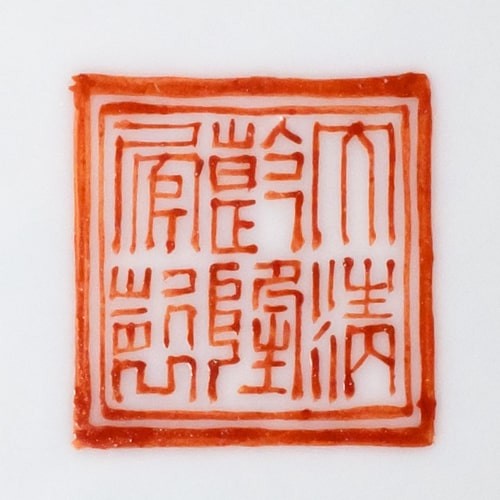
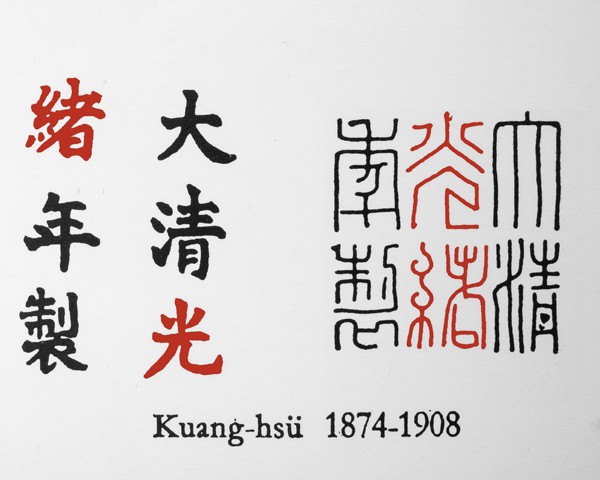
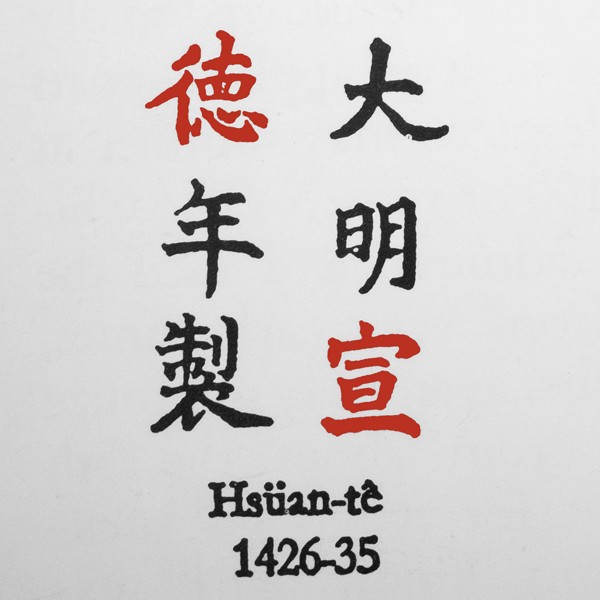
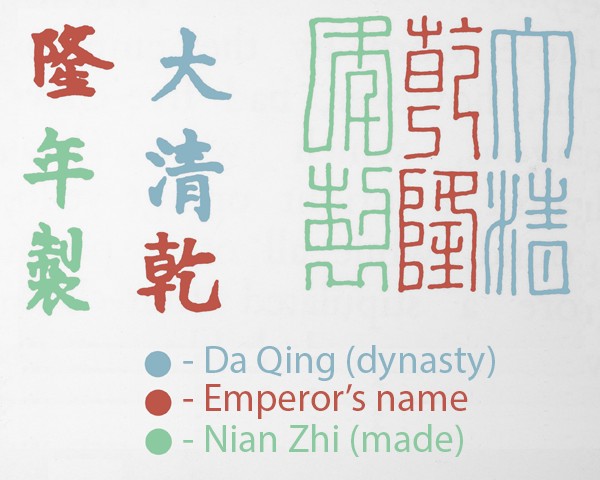
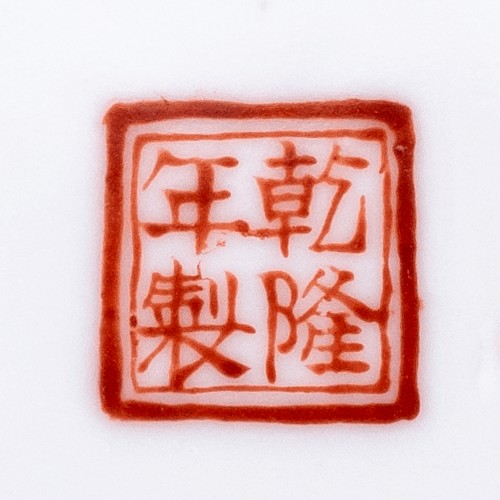
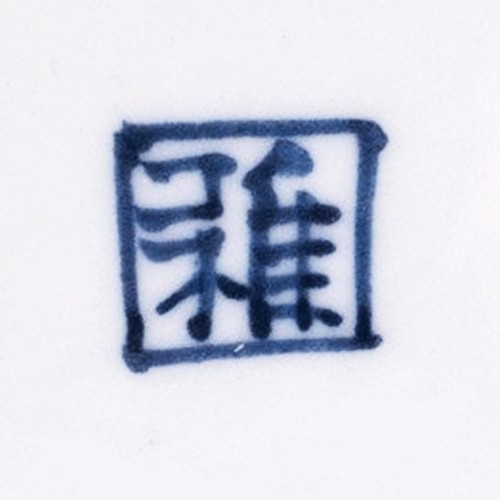
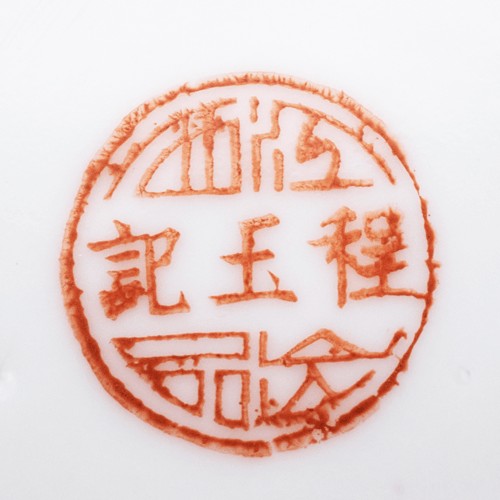
2.2. Ming Dynasty (1368-1644)
Ming Dynasty reign marks are generally simpler than those of the Qing Dynasty. They often consist of four characters, with “Da Ming” (大明) preceding the emperor’s name and “Nian Zhi.”
| Emperor | Reign Period | Mark (Traditional) | Mark (Simplified) | Notes |
|---|---|---|---|---|
| Hongwu | 1368-1398 | 洪武年製 | 洪武年制 | Marks are rare and often debated in terms of authenticity. |
| Yongle | 1402-1424 | 永樂年製 | 永乐年制 | Marks are highly prized and found on exceptional quality porcelain. |
| Xuande | 1425-1435 | 大明宣德年製 | 大明宣德年制 | Marks are considered among the finest and most meticulously written. |
| Chenghua | 1464-1487 | 大明成化年製 | 大明成化年制 | Marks are known for their delicate and somewhat whimsical style. |
| Hongzhi | 1487-1505 | 大明弘治年製 | 大明弘治年制 | Marks are relatively rare. |
| Zhengde | 1505-1521 | 大明正德年製 | 大明正德年制 | Marks are often associated with porcelain produced for the Islamic market. |
| Jiajing | 1521-1566 | 大明嘉靖年製 | 大明嘉靖年制 | Marks are common and can vary significantly in quality. |
| Longqing | 1566-1572 | 大明隆慶年製 | 大明隆庆年制 | Marks are less common than those of Jiajing. |
| Wanli | 1572-1620 | 大明萬曆年製 | 大明万历年制 | Marks are frequently encountered, but authentic examples can be difficult to identify. |
| Tianqi | 1620-1627 | 大明天啓年製 | 大明天启年制 | Marks are relatively scarce. |
| Chongzhen | 1627-1644 | 崇禎年製 | 崇祯年制 | Marks are uncommon due to the political instability of the late Ming period. |
2.3. Reading Chinese Characters
Understanding the structure and components of Chinese characters is fundamental to deciphering reign marks. Each character is composed of radicals, which are basic building blocks that convey meaning.
2.3.1. Character Structure
Chinese characters are often constructed from two or more radicals. These radicals combine to give the character its overall meaning. For example, the character for “good” (好) is made up of the radicals for “woman” (女) and “child” (子), symbolizing the traditional view of family harmony.
2.3.2. Stroke Order
The correct stroke order is essential for writing and recognizing Chinese characters. There are general rules to follow:
- Top to Bottom: Write horizontal strokes before vertical strokes.
- Left to Right: Generally, strokes are written from left to right.
- Horizontal Before Vertical: When horizontal and vertical strokes intersect, the horizontal stroke is written first.
- Center Vertical Before Sides: In symmetrical characters, the central vertical stroke is often written before the strokes on either side.
- Enclosing Frames: Top and left sides of an enclosing frame are written first, followed by the contents, and then the bottom stroke.
2.3.3. Simplified vs. Traditional Characters
It is also important to note the difference between simplified and traditional Chinese characters. Simplified characters were introduced in the mid-20th century to promote literacy, while traditional characters are still used in some regions and on older artifacts.
2.4. Common Phrases and Characters
Knowing common phrases and characters in Chinese porcelain marks is essential for accurate identification. Some examples include:
- 大 (Dà): Great
- 年 (Nián): Year
- 製 (Zhì): Made
- 年製 (Nián Zhì): Made during the reign of
- 堂 (Táng): Hall
- 珍 (Zhēn): Precious
3. Identifying Seal Marks and Other Markings
Besides reign marks, Chinese porcelain often features seal marks, hall marks, and other symbols. These markings can provide additional information about the origin and quality of a piece.
3.1. Seal Marks (篆書款)
Seal marks are stylized versions of reign marks written in seal script (篆書), an ancient calligraphic style. They were particularly popular during the Qianlong period and are often found in a square or rectangular format.
- Characteristics: Seal marks are characterized by their intricate, geometric forms and the use of thick, even strokes.
- Interpretation: Reading seal marks can be challenging due to their stylized nature. However, knowledge of seal script and common reign marks can aid in their identification.
3.2. Hall Marks (堂名款)
Hall marks indicate the specific workshop, studio, or even the personal collection of an individual associated with the production or ownership of the porcelain.
- Characteristics: Hall marks can vary widely in style and content. Some may include the name of a famous studio or workshop, while others may reference a particular location or artistic theme.
- Significance: Hall marks can provide valuable insights into the provenance and quality of a piece, especially when associated with known workshops or collectors.
3.3. Auspicious Symbols (吉祥圖案)
Auspicious symbols are decorative motifs with symbolic meanings, often used in place of or alongside reign marks and other inscriptions.
- Common Symbols: Some common auspicious symbols include the Eight Treasures (八寶), the Three Friends of Winter (歲寒三友), and various floral and animal motifs.
- Interpretation: Understanding the meaning of these symbols can provide a deeper appreciation of the artistic and cultural context of the porcelain.
3.4. Potter’s Marks (人名款)
Potter’s marks are the signatures or marks of the individual artisans who created the porcelain.
- Rarity: Potter’s marks are less common than reign marks or hall marks, particularly on imperial wares.
- Significance: When present, potter’s marks can add significantly to the value and historical interest of a piece, especially if the potter is a known and respected figure.
4. Recognizing Apocryphal Marks and Reproductions
One of the biggest challenges in identifying Chinese porcelain is distinguishing genuine marks from apocryphal marks and reproductions. Apocryphal marks are marks that intentionally imitate those of earlier periods, either as a sign of respect or to deceive buyers.
4.1. Characteristics of Apocryphal Marks
- Incorrect Calligraphy: Apocryphal marks often exhibit flaws in calligraphy, such as poorly formed characters, uneven spacing, or incorrect stroke order.
- Inconsistent Style: The style of the mark may be inconsistent with the period it purports to represent. For example, a Ming Dynasty reign mark may be found on a piece with Qing Dynasty decorative motifs.
- Poor Execution: Apocryphal marks may be poorly executed, with smudged ink, uneven lines, or a lack of attention to detail.
4.2. Identifying Reproductions
- Material and Craftsmanship: Reproductions often lack the quality of materials and craftsmanship found in genuine antique porcelain. The clay may be less refined, the glaze may be uneven, and the painting may be crude or imprecise.
- Wear and Patina: Reproductions typically lack the wear and patina that develop on antique porcelain over time. However, some forgers may attempt to artificially age their pieces.
- Technical Analysis: Advanced techniques such as X-ray fluorescence (XRF) and thermoluminescence dating can be used to determine the age and composition of porcelain, helping to identify reproductions.
4.3. Tips for Avoiding Fakes
- Buy from Reputable Dealers: Purchase porcelain from reputable dealers with expertise in Chinese art and antiques.
- Examine the Piece Carefully: Carefully examine the piece for any signs of inconsistency or poor quality.
- Consult Experts: Seek the advice of experienced collectors, curators, or appraisers.
- Do Your Research: Educate yourself about Chinese porcelain marks, styles, and manufacturing techniques.
5. The Impact of Marks on Value and Collectibility
The presence, quality, and authenticity of marks can significantly impact the value and collectibility of Chinese porcelain.
5.1. Reign Marks and Value
- Genuine Imperial Pieces: Porcelain bearing genuine reign marks from esteemed periods like Kangxi, Yongzheng, and Qianlong of the Qing Dynasty or Xuande and Chenghua of the Ming Dynasty are often highly prized and command substantial prices.
- Apocryphal Marks: While the presence of an apocryphal mark can detract from the value of a piece, it does not necessarily render it worthless. The overall quality, rarity, and aesthetic appeal of the porcelain can still contribute to its value.
5.2. Hall Marks and Collectibility
- Provenance: Hall marks can enhance the collectibility of a piece by providing insights into its provenance and association with known workshops or collectors.
- Artistic Merit: Porcelain bearing hall marks from renowned studios or workshops may be particularly sought after by collectors interested in specific artistic styles or techniques.
5.3. Condition and Rarity
- Overall Condition: The condition of the porcelain, including any chips, cracks, or repairs, can also affect its value. Pieces in excellent condition are generally more desirable than those with significant damage.
- Rarity: The rarity of a particular type of mark or decorative motif can also influence its value. Pieces with unique or unusual markings may be highly prized by collectors.
6. Resources for Further Study
For those interested in delving deeper into the study of Chinese porcelain marks, there are many valuable resources available.
6.1. Books and Publications
- “Chinese Ceramics: The New Standard Guide” by He Li: A comprehensive overview of Chinese ceramics, including detailed information on marks and dating.
- “The Book of Famille Rose” by George C. Williamson: An in-depth study of famille rose porcelain, with extensive illustrations of marks and decorative motifs.
- “Later Chinese Porcelain: Qing Dynasty 1644-1912” by Maria Antoinetta Pinto de Matos: A detailed guide to Qing Dynasty porcelain, with a focus on reign marks and stylistic developments.
6.2. Museums and Collections
- The Palace Museum, Beijing: Home to one of the world’s largest and most comprehensive collections of Chinese porcelain, including many pieces with imperial marks.
- The Metropolitan Museum of Art, New York: Features a diverse collection of Chinese ceramics, with examples from various dynasties and periods.
- The British Museum, London: Houses an extensive collection of Chinese porcelain, including pieces acquired during the Qing Dynasty.
6.3. Online Resources
- CONDUCT.EDU.VN: Offers a wealth of information on Chinese porcelain marks, including articles, images, and identification guides.
- Gotheborg.com: A comprehensive website dedicated to Asian ceramics, with a large database of marks and maker’s marks.
- Asian Art Newspaper: Provides news, articles, and exhibition reviews related to Asian art, including Chinese porcelain.
7. Case Studies: Identifying Marks in Practice
To illustrate the process of identifying Chinese porcelain marks, let’s examine a few case studies.
7.1. Case Study 1: A Qing Dynasty Vase
A collector discovers a vase with a six-character reign mark on the base. The mark reads “Da Qing Qianlong Nian Zhi” (大清乾隆年製).
- Analysis: The mark indicates that the vase was made during the reign of the Qianlong Emperor (1735-1796) of the Qing Dynasty.
- Authentication: The collector examines the calligraphy of the mark, the quality of the porcelain, and the style of the decoration to determine whether the piece is genuine or a reproduction.
7.2. Case Study 2: A Ming Dynasty Bowl
An antique dealer acquires a bowl with a four-character reign mark on the base. The mark reads “Da Ming Xuande Nian Zhi” (大明宣德年製).
- Analysis: The mark suggests that the bowl was made during the reign of the Xuande Emperor (1425-1435) of the Ming Dynasty.
- Authentication: The dealer consults with experts and conducts technical analysis to confirm the authenticity of the piece and the mark.
7.3. Case Study 3: A Republic Period Plate
A homeowner finds a plate with a stamped red mark on the base. The mark includes Chinese characters and the phrase “Made in China.”
- Analysis: The mark indicates that the plate was made during the Republic period (1912-1949) or later, likely for export.
- Valuation: While the plate may not be as valuable as an imperial piece, it still holds historical and decorative value.
8. The Future of Porcelain Mark Identification
As technology continues to advance, new tools and techniques are being developed to aid in the identification and authentication of Chinese porcelain marks.
8.1. Digital Databases
Online databases and image recognition software are making it easier to compare marks and identify potential matches.
8.2. Artificial Intelligence
AI-powered systems can analyze the calligraphy and style of marks, helping to distinguish genuine marks from apocryphal marks and reproductions.
8.3. Advanced Imaging Techniques
Advanced imaging techniques such as 3D scanning and hyperspectral imaging can reveal subtle details in marks that are not visible to the naked eye.
9. Conclusion: Mastering the Art of Porcelain Identification
Understanding the marks on Chinese porcelain is an ongoing process of learning and discovery. By studying the history, styles, and techniques of Chinese ceramics, collectors and enthusiasts can develop the skills and knowledge needed to identify and appreciate these exquisite works of art.
9.1. The Importance of Continuous Learning
- Stay Updated: The field of Chinese porcelain studies is constantly evolving, with new discoveries and insights emerging regularly. Stay informed about the latest research and developments.
- Share Knowledge: Share your knowledge and expertise with other collectors and enthusiasts, helping to promote a deeper appreciation of Chinese porcelain.
9.2. CONDUCT.EDU.VN: Your Partner in Ethical Understanding
At CONDUCT.EDU.VN, we are committed to providing comprehensive resources and guidance on Chinese porcelain marks. Our goal is to empower collectors and enthusiasts with the knowledge and tools they need to make informed decisions and appreciate the beauty and history of these remarkable artifacts.
9.3. A Call to Action
Do you find yourself struggling to decipher the markings on your cherished porcelain pieces? Are you uncertain about the authenticity or historical significance of your collection? Don’t let these questions linger. Visit CONDUCT.EDU.VN today for expert guidance, detailed resources, and personalized assistance in unraveling the mysteries of Chinese porcelain marks.
Contact Us:
- Address: 100 Ethics Plaza, Guideline City, CA 90210, United States
- WhatsApp: +1 (707) 555-1234
- Website: CONDUCT.EDU.VN
Unlock the secrets of your porcelain collection and deepen your appreciation for Chinese art history with CONDUCT.EDU.VN.
10. Frequently Asked Questions (FAQ)
1. What is a reign mark on Chinese porcelain?
A reign mark is an inscription, usually found on the base of the piece, that indicates the emperor’s reign during which the porcelain was made. It typically consists of six characters arranged in two columns, read from right to left and top to bottom.
2. How do I read a Chinese porcelain mark?
Chinese porcelain marks are read from right to left and top to bottom. The first two characters usually denote the dynasty, followed by the emperor’s name and the phrase “Nian Zhi” (年製), meaning “made during the reign.”
3. What is an apocryphal mark?
An apocryphal mark is a mark that intentionally imitates those of earlier periods, either as a sign of respect or to deceive buyers.
4. How can I tell if a Chinese porcelain mark is genuine?
To determine if a mark is genuine, examine the calligraphy, the quality of the porcelain, and the style of the decoration. Consult experts and conduct technical analysis if necessary.
5. What is the significance of hall marks on Chinese porcelain?
Hall marks indicate the specific workshop, studio, or personal collection associated with the production or ownership of the porcelain. They can provide valuable insights into the provenance and quality of a piece.
6. What are some common auspicious symbols found on Chinese porcelain?
Some common auspicious symbols include the Eight Treasures (八寶), the Three Friends of Winter (歲寒三友), and various floral and animal motifs.
7. How does the presence of a mark affect the value of Chinese porcelain?
The presence, quality, and authenticity of marks can significantly impact the value of Chinese porcelain. Genuine marks from esteemed periods are often highly prized.
8. Where can I find more information about Chinese porcelain marks?
You can find more information about Chinese porcelain marks at conduct.edu.vn, as well as in books, museums, and online resources.
9. What is the difference between simplified and traditional Chinese characters?
Simplified characters were introduced in the mid-20th century to promote literacy, while traditional characters are still used in some regions and on older artifacts.
10. Is it always possible to determine the authenticity of a Chinese porcelain mark?
While many marks can be authenticated with careful examination and expert analysis, some marks remain difficult to verify due to their complexity or the lack of available information.